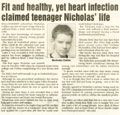Ballinderry schoolboy Nicholas Collins was just 16 years of age when he suffered from a fatal viral infection in 1998.
At the time knowledge of causes of heart diseases among young people was relatively scant. The keen, fit, basketball player spent seven weeks at the coronary care unit at the City Hospital, Belfast before passing away on November 24, 1998. Later it was revealed a viral infection caused his heart muscles to inflame and he suffered from a fatal haemorrhage.
The first signs Nicholas was unwell were in October 1998 when he returned home from college one Friday complaining of a sore throat and flu. He didn’t feel well enough to go to basketball practice in Lisburn.
Although he was prescribed antibiotics the doctor later had him admitted to the Lagan Valley Hospital. From there he was sent to the coronary care unit at the City Hospital where he was to spend the next seven weeks.
During his time there it was revealed that a viral infection had caused his heart muscles to inflame. His temperature and heart rate would fluctuate. Numerous tests were carried out but as time went by he got weaker and weaker.
At times he seemed to be improving and his mother even told the owner of a computer shop where he had applied for a part-time job that he could start work before Christmas. But Nicholas took a turn for the worse and suffered a fatal haemorrhage and despite having a blood transfusion passed away.
Brenda feels that her son may have died sooner, like other high profile more recent cases like Cormac McAnallen, if he had not been admitted to hospital when he was.
She knows doctors tried their best during his stay and that his hospital care was excellent. She feels that potentially life threatening heart conditions among the young can sometimes not be taken seriously enough.
“A sports teacher once told me that many young sporty men are very competitive and never want to complain that they are unwell,” she said.
“It is as though they find it hard to admit they do not feel well and just keep on going – not to let the side down.”
Brenda agreed to Nicholas’s picture being used on the CRY campaign postcards to encourage people to demand action by raising awareness among the general public as well as within the medical profession.
“Families are often told that this is a very rare event and so they think that their case is unique but over the years a lot of young people have died of these conditions and at least some of these deaths might have been prevented,” she said.






